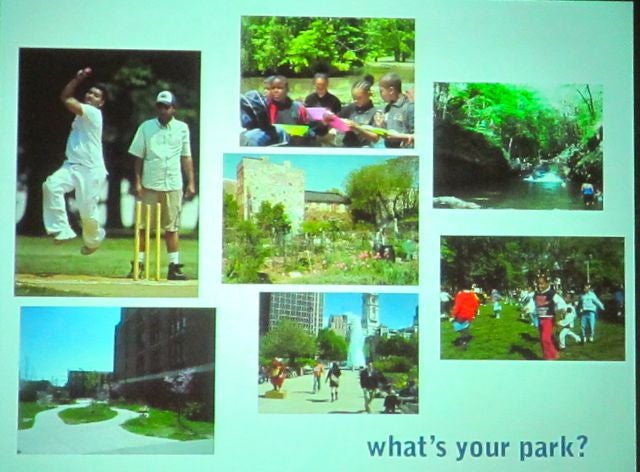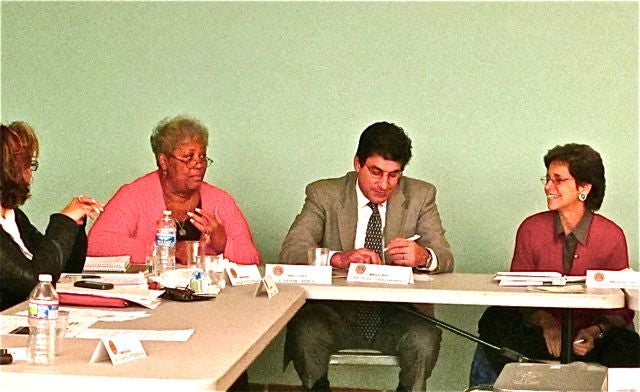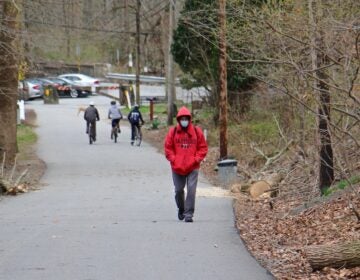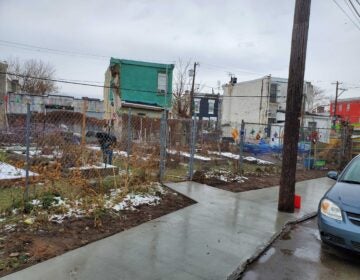Final land ordinance and a Green 2015 run through
At Wednesday evening’s final 2010 Parks & Recreation Commission meeting, held at the Central Branch of the Free Library, the talk was of adding parkland. It made a welcome switch from the matters of land disposition that have lately concerned the newly-merged parks and recreation departments.
PennPraxis director, Harris Steinberg, offered a quick run-through of a study the group prepared for the Commission. It outlines the whys, wheres, and hows the system can add the 500 acres of new open space called for in the City’s Green 2015 plan, and builds on input from a 40-member advisory council, more than 140 stakeholders, and some 200 citizens who attended six civic engagements meetings held over the summer.
Steinberg said the chief question behind identifying potential new parkland was “What’s your park?” Today’s parks, he said, are charged with several simultaneous mandates, including sustainability tasks, positively impacting property vales, and contributing to public health.
Chief among the City’s goals, he added, is the notion of equity and access. PennPraxis is primarily focusing on five under-greened areas that together play home to 12 percent of the city’s population. Since the City is also most interested in better using the assets it already has — rather than acquiring new land — PennPraxis researchers have honed in on opportunities like the nearly 500 acres already occupied by impervious schoolyards and tree-free rec centers.
In addition, vast swathes of vacant public land, as well as undeveloped private land, are potential sites.
To align with the Philadelphia City Planning Commission’s 2035 plan, Steinberg said that open space developed along the city’s riparian ways, rail corridors, and historic creek beds will go a long way toward creating a network of pathways, greenways, and connected trails.
Already the City has about 100 acres under development, Steinberg pointed out, and another 105 acres have been identified.
During a question and answer period, Parks & Recreation head Mike DiBerardinis reiterated that an emphasis would be made on leveraging land already publicly owned and that the idea is to “build on existing policy objectives” being pursued by City departments such as the School District and agencies such as the Philadelphia Water Department.
About the School District’s embrace of such plans, DiBerardinis added, “It’s an interesting ride. . . . They understand this won’t work on the retail level — it has to be wholesale.” He added that P&R hoped that retrofitting of schoolyards could be integrated into the District’s facilities master plan. He later added that P&R hoped to alleviate the District’s nervousness about taking care of green spaces — something not currently in its purview — by establishing the idea of public stewardship, providing P&R training, and allowing the District to buy into its own existing maintenance contracts.
A questioner from the audience who lives in East Falls — “we’re very lucky, we’re very green” — wondered if any provision would be made, after equity concerns were addressed, to return parkland to other areas that had lost it. “In a very general way, yes,” said DiBerardinis. “I believe that acquisition of land is about interest, politics, and opportunity.”
Steinberg added that the plan is not “prescriptive” but instead provides a “set of criteria to guide the city in choice-making.”
Commissioner Jeffrey Hackett wondered how blighted factory buildings along the East – West artery of Lehigh Avenue might fit into the picture. Steinberg noted that while light industrial corridors like Washington Avenue are ripe for greening, the study hadn’t specifically examined vacant buildings.
We are, Steinberg noted, a “land-rich city.”
The meeting concluded with several brief committee reports. On behalf of the Land Use Committee, Chair Nancy Goldenberg briefed attendees on the now-final draft of the Commission’s Open Land Protection Ordinance, noting several changes and additions incorporated as a result of public hearings. These include a full page of language that is specifically pro-park, a provision that calls for a description of the environmental impact of a proposed transfer or conversion, and reworkings of the details surrounding City Council’s review and approval of land transfers or conversions.
The Commission will vote on this version at its next scheduled meeting, January 19, 2011. At that point, Goldenberg said, the process will only be about half-way through. After review by Council, and additional public hearings, the goal is to have the ordinance in place by late March.
Commissioner Pete Hoskins next offered the report of the Revenue Enhancement Committee, detailing a study that is underway to examine the system’s relationships with concessions and lease-holders. At the same time, he said, the Committee is putting together case studies of how six other cities — San Francisco, Minneapolis, Seattle, Los Angeles, New York City, and Portland, OR — manage their concession systems.
Commissioner Carol Rice introduced a new program, PaRC Stars, of her Communications Committee. Intended to celebrate the “unsung heroes” who do so much for the city’s parks and rec centers, the initiative is accepting nominations on an ongoing basis. At each P&R meeting, one volunteer will be recognized.
The evening ended with general news, including a mention of a Philadelphia Inquirer front page profile of DiBerardinis, another Inquirer story about the renovation of Clark Park, and an upcoming Tree Tenders event.
Contact JoAnn Greco at www.joanngreco.com
Check out her new online magazine, TheCityTraveler at www.thecitytraveler.com
WHYY is your source for fact-based, in-depth journalism and information. As a nonprofit organization, we rely on financial support from readers like you. Please give today.








